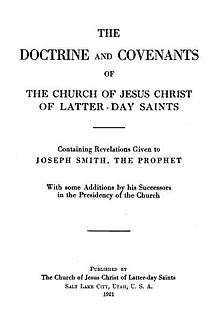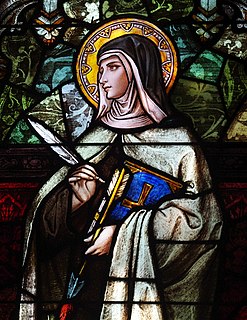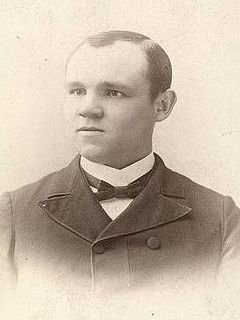The Apostles' Creed, sometimes titled the Apostolic Creed or the Symbol of the Apostles, is an early statement of Christian belief—a creed or "symbol". It is widely used by a number of Christian denominations for both liturgical and catechetical purposes, most visibly by liturgical Churches of Western tradition, including the Catholic Church, Lutheranism and Anglicanism. It is also used by Presbyterians, Moravians, Methodists and Congregationalists.

A creed is a statement of the shared beliefs of a religious community in the form of a fixed formula summarizing core tenets.

The Doctrine and Covenants is a part of the open scriptural canon of several denominations of the Latter Day Saint movement. Originally published in 1835 as Doctrine and Covenants of the Church of the Latter Day Saints: Carefully Selected from the Revelations of God, editions of the book continue to be printed mainly by The Church of Jesus Christ of Latter-day Saints and Community of Christ.

Mormonism is the predominant religious tradition of the Latter Day Saint movement of Restorationist Christianity started by Joseph Smith in Western New York in the 1820s and 30s.

The Nicene Creed is a statement of belief widely used in Christian liturgy. It is called Nicene because it was originally adopted in the city of Nicaea by the First Council of Nicaea in 325. In 381, it was amended at the First Council of Constantinople, and the amended form is referred to as the Nicene or the Niceno-Constantinopolitan Creed.

A saint is a person who is recognized as having an exceptional degree of holiness or likeness or closeness to God. However, the use of the term "saint" depends on the context and denomination. In Roman Catholic, Eastern Orthodox, Anglican, Oriental Orthodox, and Lutheran doctrine, all of their faithful deceased in Heaven are considered to be saints, but some are considered worthy of greater honor or emulation; official ecclesiastical recognition, and consequently veneration, is given to some saints through the process of canonization in the Catholic Church or glorification in the Eastern Orthodox Church.

The Thirty-nine Articles of Religion are the historically defining statements of doctrines and practices of the Church of England with respect to the controversies of the English Reformation. The Thirty-nine Articles form part of the Book of Common Prayer used by both the Church of England and the Episcopal Church. Several versions are available online.
In the Latter Day Saint movement, priesthood is the power and authority of God given to man, including the authority to perform ordinances and to act as a leader in the church. A body of priesthood holders is referred to as a quorum.

The Latter Day Saint movement is the collection of independent church groups that trace their origins to a Christian Restorationist movement founded by Joseph Smith in the late 1820s.

The communion of saints, when referred to persons, is the spiritual union of the members of the Christian Church, living and the dead, excluding therefore the damned. They are all part of a single "mystical body", with Christ as the head, in which each member contributes to the good of all and shares in the welfare of all.

James Edward Talmage was an English chemist, geologist, and religious leader who served as a member of the Quorum of the Twelve Apostles of The Church of Jesus Christ of Latter-day Saints from 1911 until his death.

Nicene Christianity is a set of Christian doctrinal traditions which reflect the Nicene Creed, which was formulated at the First Council of Nicaea in AD 325 and amended at the First Council of Constantinople in AD 381.

The Pearl of Great Price is part of the canonical standard works of The Church of Jesus Christ of Latter-day Saints and some other Latter Day Saint denominations.
Jesus the Christ: A Study of the Messiah and His Mission According to the Holy Scriptures Both Ancient and Modern is a 1915 book by James E. Talmage. The book is a doctrinal study on the life and ministry of Jesus Christ and is widely appreciated by members of The Church of Jesus Christ of Latter-day Saints. The book consists of 42 chapters, each focusing on important aspects of the life and mission of Jesus as the Messiah.

In The Church of Jesus Christ of Latter-day Saints, the Holy of Holies is a room in the Salt Lake Temple wherein the church's president—acting as the Presiding High Priest of the church—enters to act as High Priest of Israel in direct relationship with God, in accordance with the LDS interpretation of the Book of Exodus. Hence, this Holy of Holies in the temple is considered by adherents to be a modern cognate to the inner sanctuary of the Tabernacle and Temple in Jerusalem. The room was also the place where the second anointing ordinance was administered, although, now any room in a temple set apart for this purpose is used.
An auxiliary organization is a secondary body of church government within The Church of Jesus Christ of Latter-day Saints that is "established for moral, educational, and benevolent purposes." As their name suggests, LDS Church auxiliary organizations are ancillary to the governing power of the priesthood in the church. The five auxiliary organizations of the LDS Church are Primary, Relief Society, Sunday School, Young Men, and Young Women.
The Articles of Faith: A Series of Lectures on the Principal Doctrines of the Church of Jesus Christ of Latter-day Saints is an 1899 book by James E. Talmage about doctrines of The Church of Jesus Christ of Latter-day Saints. The name of the book is taken from the LDS Church's "Articles of Faith", an 1842 creed written by Joseph Smith.
The Great Apostasy Considered in the Light of Scriptural and Secular History is a 1909 book by James E. Talmage that summarizes the Great Apostasy from the viewpoint of The Church of Jesus Christ of Latter-day Saints.

Introduction to Christianity is a 1968 book written by Joseph Ratzinger. Considered one of his most important and widely read books, it presents a "narrative Christology" that demonstrates the place for faith is in the Church. The book offers a "remarkable elucidation of the Apostle's Creed" and gives an "excellent, modern interpretation of the foundations of Christianity".









